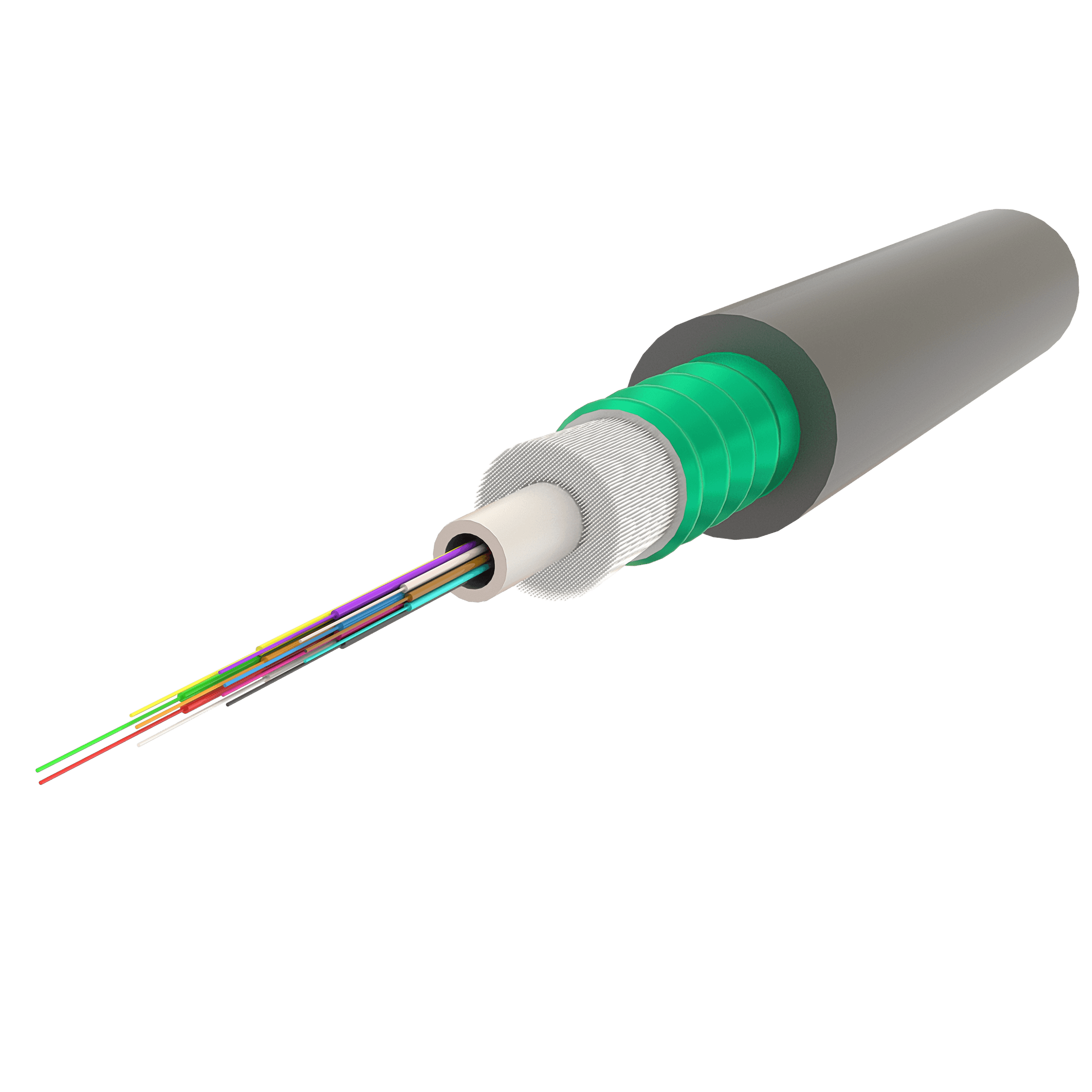Outdoor Armored Fiber Optic Cable Single PE Jacket Outdoor Type Fiber Optic Cable designs are the cost saving. Also, robust structure is a good solution for access. Therefore, distribution for campus & industrial plant, mining or those areas where the cable may be exposed to physical damage. Also, the fibers are placed within a gel-filled loose tube. For low fiber count up to 24 FO. Also, Central Loose Tube Armored structure is available.
Therefore, outdoor fiber optic cable guarantees the protection of cable where the mechanical damage risk exists. Also, to guarantee stability towards environmental influences such as frost and humidity. Glass yarns are applied over the tube to provide additional tensile strength and rodent protection to the cable. Also, corrugated steel tape armor provides additional mechanical (crush and rodent) protection with a high-strength ripcord. Ripcord is under the armor for easy stripping. UV (Ultra Violet) resistant Polyethylene (PE) sheath. UV PE sheath is resistant to stress cracking and UV radiation. On request, following options are available:
Color options for sheath, tube and fiber
Increased Tensile strength (Aramid yarn or Glass Yarn)
Non-metallic version
L-M-HDPE or LSZH sheath.
Compliance – Outdoor Armored Fiber Optic Cable
- IEC 60754-1, IEC 61034-1&2, IEC 60794-1&2, ROHS, TIA/EIA;
- IEC: International Electrotechnical Commission (IEC) is an international standards organization that publishes standards for the electrical and electronics industries. IEC standard 60794-1-2 covers the general requirements for fiber optic cables, including mechanical, environmental, and performance requirements.
- RoHS: Restriction of Hazardous Substances (RoHS) is a European Union directive that limits the use of certain hazardous materials in electronic products. RoHS compliance is mandatory for outdoor armored fiber optic cables sold in the EU.
- TIA/EIA: Telecommunications Industry Association/Electronic Industries Alliance (TIA/EIA) is a US-based standards organization that publishes standards for the telecommunications industry. TIA/EIA standards such as TIA/EIA-568-B.3 and TIA/EIA-526-14A cover the mechanical, environmental, and performance requirements for fiber optic cables in commercial and industrial settings.
Application – Outdoor Armored Fiber Optic Cable
- Inter Building and Intra-building Voice or Data Communication Networks
- Inter Building Voice or Data Communication Networks
- FTTC Cabling
- Outside Plant
- Installed in Ducts & Conduits
- Secondary Distribution
- LAN & WAN
- FTTB Cabling,
- Campus Cabling
- Directly Buried Underground
- Telecommunication Data Trunk Systems
- Harsh Premises Environments requiring heavy duty protection
- Interconnection of Distribution Boxes, Distribution Frames and the Panels at Customer Side
Features and Benefits
- Compact
- Waterproof
- Enforcement with Non-Metallic Strength Members
- Loose Tube
- Jelly Filled Tube
- UV- Resistant
- Metallic Armor Protected
- Enhanced Rodent Resistance
- Polyethylene Outer Sheath
- High Crush & Impact Resistance
- Moisture Barrier
- A-DQ(BN)(SR)2Y–CLT – Central Loose Tube Metallic Armored
Outdoor armored fiber optic cables have a number of features and benefits that make them well-suited for use in harsh outdoor environments:
- Durability: The armor on these cables provides protection against physical damage such as crushing, bending, and impact, which makes them ideal for use in industrial and other high-traffic areas.
- Weather resistance: Outdoor armored fiber optic cables are designed to withstand harsh environmental conditions such as rain, snow, and high temperatures, which makes them suitable for use in a wide range of outdoor applications.
- High performance: These cables are designed to support high-speed data transmission over long distances, which makes them ideal for use in telecommunications and internet service provider applications.
- Low attenuation: The optical fibers used in these cables have a low attenuation (or loss of signal) rate, which allows for high-quality data transmission over long distances.
- Versatility: Outdoor armored fiber optic cables are available in a variety of configurations, including single-mode and multi-mode, and can be used in a wide range of applications such as telecommunications, internet service providers, and cable television.
- Easy to install: The armored design of these cables makes them easy to install in a wide range of environments and applications, and allows for quick and easy maintenance.
- Cost-effective: Outdoor armored fiber optic cables are a cost-effective option for high-speed data transmission over long distances, as they require less power and have a longer lifespan than other types of cables.
- In summary, the main features of outdoor armored fiber optic cables are their durability, weather resistance, high performance, low attenuation, versatility, easy installation, and cost-effectiveness. These features make them an ideal choice for a wide range of outdoor applications in harsh environment.
Specification
| Fibers | 2 | 4 | 6 | 8 | 12 | |
| Loose Tube Ø (mm) | 3.0 | |||||
| Loose Tube Jacket | PBT | |||||
| Strength members | Water Blocking Glass Yarn | |||||
| Armor | Corrugated | |||||
| Outer jacket | Polyethylene | |||||
| Weight (Kg/Km) | 85 | 85 | 85 | 85 | 85 | |
| Outer Ø (mm) | 7, 5 | 7, 5 | 7,5 | 7,5 | 7,5 | |
| Tensile Load Perm/Inst (N) | 800/1200 | 800/1200 | 800/1200 | 800/1200 | 800/1200 | |
| Optical Characteristic | 9/125 G.G652.D | 50/125 OM2 | 50/125 OM3 | 50/125 OM4 | ||
| Bandwidth (nm) | 1550/1310 | 850/1300 | 850/1300 | 850/1300 | ||
| Attenuation (max dB/km ) | 0.22/0.36 | 3.0/1.0 | 2.8/0.8 | 2.7/0.7 | ||
| Crush (N) | 2000 (IEC 60794-1-2 E3) | |||||
| Temperature Range | -30 ºC to +70 ºC (IEC 60794-1-2 F1) |
Central Loose Tube Metallic Armored
Outdoor Armored Fiber Optic Cable
Outdoor armored fiber optic cable is a type of cable that is designed for use in outdoor environments. It typically consists of a central core made of optical fibers, which are surrounded by a protective sheath and an outer armor. The armor is typically made of a material such as aluminum or steel, and is designed to provide protection against physical damage and environmental factors such as water, UV radiation, and temperature changes. Outdoor armored fiber optic cable is often used in applications such as telecommunications, internet service providers, and cable television. It is also used in industrial and military settings where the cable needs to be able to withstand harsh conditions.
Standards and Compliances
Outdoor armored fiber optic cables must comply with a number of standards and regulations in order to ensure their safe and proper operation. Some of the key standards and compliance requirements for these cables include:
- UL: Underwriters Laboratories (UL) is a safety science organization that tests and certifies products for compliance with safety standards. UL’s standard for fiber optic cables, UL 1666, covers the safety requirements for riser and plenum-rated cables, which are used in vertical and horizontal cable runs, respectively.
- IEC: International Electrotechnical Commission (IEC) is an international standards organization that publishes standards for the electrical and electronics industries. IEC standard 60794-1-2 covers the general requirements for fiber optic cables, including mechanical, environmental, and performance requirements.
- RoHS: Restriction of Hazardous Substances (RoHS) is a European Union directive that limits the use of certain hazardous materials in electronic products. RoHS compliance is mandatory for outdoor armored fiber optic cables sold in the EU.
- TIA/EIA: Telecommunications Industry Association/Electronic Industries Alliance (TIA/EIA) is a US-based standards organization that publishes standards for the telecommunications industry. TIA/EIA standards such as TIA/EIA-568-B.3 and TIA/EIA-526-14A cover the mechanical, environmental, and performance requirements for fiber optic cables in commercial and industrial settings.
It’s important to note that these are just a few examples of the standards and regulations that outdoor armored fiber optic cables must comply with. Additionally, for specific application like military and aerospace, there are other requirements that need to be met such as MIL-STD-810 or NASA-STD-8739.1. It’s important to check the specific standards and regulations that apply to the application the cable will be used for.
Maintenance and Storage Instructions
Proper maintenance and storage of outdoor armored fiber optic cables is essential to ensure their longevity and reliable performance. Here are some guidelines for maintaining and storing these cables:
- Handling: Be careful when handling the cable to avoid damage to the armor or fibers. Use proper equipment such as cable grips or pulling eyes to avoid crushing or kinking the cable.
- Cleaning: Clean the cable and connectors with a lint-free cloth and a mild cleaning solution such as isopropyl alcohol. Avoid using harsh chemicals or abrasives, which can damage the armor or fibers.
- Storage: Store the cable in a dry, cool, and well-ventilated area. Avoid storing the cable in areas where it may be exposed to extreme temperatures, moisture, or UV radiation.
- Inspection: Inspect the cable and connectors regularly for damage such as cuts, abrasions, or signs of corrosion. Repair or replace any damaged components as needed.
- Environmental factors: Outdoor armored fiber optic cables are designed to withstand harsh environmental conditions, but they still need to be protected from extreme temperatures, moisture, and UV radiation to ensure their longevity and reliable performance.
- Connectors: Connectors are particularly sensitive components, ensure to protect them from dust, moisture, and other contaminants. Keep them clean and inspect them regularly for signs of damage or wear.
Overall, handling and maintaining outdoor armored fiber optic cables with care and following the manufacturer’s guidelines will help to ensure their long-term performance and reliability.


